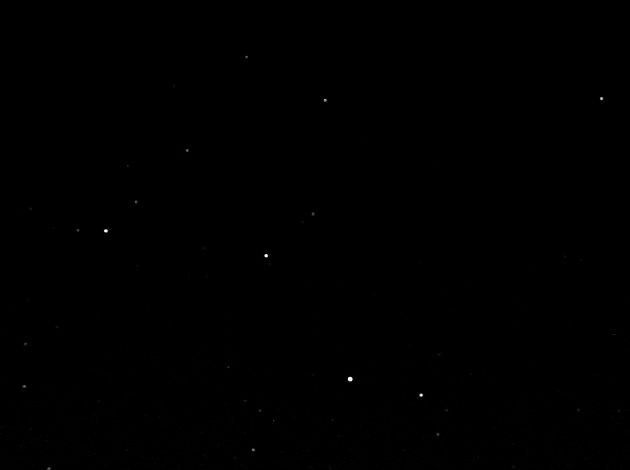

The picture below shows the majority of Corona Borealis as well as Boötes and part of Serpens. To distinguish the stars of Boötes from those of other constellations, I have put the Bayer designations of the stars of Boötes in brackets, but have left off the brackets for stars from other constellations.

Traditionally astronomers refer to Boötes (pronounced bow-er-tees) as a herdsman, but Jenny March refers to him as a ploughman. His story starts as usual with Zeus who seduced Selene, daughter of Kadmos the King of Thebes, who conceived an immortal son. However before she gave birth, Zeus killed her (one assumes accidentally—it's a long story) but grabbed his son from her womb and stitched him into a gash in his own thigh where he grew to term. The son, Dionysos, later fetched his mother from Hades, made her immortal and moved her to Olympos where she became known as Thyrone. Dionysos became the god of wine and intoxication, ritual madness, and theatre and impersonation. For some time mortals refused to accept the deity of Dionysos and many came to a sticky end as a result. However, eventually he was accepted and, in the reign of Pandion, the worship of Dionysos was instigated in Attica and Dionysos gave a vine to a humble farmer called Ikarios and taught him how to make wine. So Ikarios became a viniculturist. Wanting to share his pleasure, Ikarios gave wine to a bunch of shepherds who quickly became drunk. Thinking Ikarios had tried to poison them, they killed him and buried his body under a tree. His daughter, Erigone, searched for him but only found his body when his dog, Maira, lead her to her father's grave. Erigone was so upset she hanged herself from the tree and the dog jumped into a well and drowned. Dionysos was so angered by these deaths that he sent a madness on Athenian girls who hanged themselves from trees. Athenians discovered the cause of this madness from the Oracle in Delphi and hanged the murderous shepherds and instigated a festival at the grape harvest in which girls swung on ropes suspended from trees with their feet resting on small wooden boards, (thus was born the children's swing). Dionysos immortalised his followers by putting Ikarios into the sky as Boötes, Maira as Canis Minor and Erigone as Virgo.
This is not the only explanation of Boötes. He is traditionally represented as a herdsman holding his two dogs, Chara and Asterion, in the form of the faint constellation, Canis Venatici, only one star of which, Cor Caroli, appears in my picture. Boötes is driving oxen attached to the plough (Ursa Major) and to the polar axis and so keeps the heavens rotating. He is said to have invented the plough for which service he was given a place in the sky.
There is not a lot of astronomical interest in Boötes. Its principal star, Aldebaran, is the brightest star in the northern hemisphere and a very distinctly orange colour. It is 41 light-years away and 100 times as luminous as the Sun. It has the unusually high proper motion of 2.3 arc-seconds per year and in 1718 Edmond Halley noticed that it had moved appreciably since ancient times. The reason is that it is a part of the galactic halo and in a highly inclined orbit and currently approaching us at 5 Km/sec. but in a few thousand years will pass us and recede to below naked-eye visibility in around 500,000 years time. Patrick Moore states that Izar (ε) is a beautiful double with the primary being orange and the secondary bluish. However it has a separation of only 2.8 arc-seconds, so needs good seeing to separate. With imaging and a lot of digital manipulation I have managed to make this image of Izar on a night of poor seeing. The colours have been enhanced to show that the brighter component is indeed orange and the fainter component is blue. (The strange shape of the brighter component results from the poor seeing.) ζ is also a binary with two equally-bright components (magnitude 4.5 and 4.6) separated by less than 1 arc-second The constellation also contains what was at one time the most remote known galaxy at 5,000 million light years, but contains no nebulous objects brighter than magnitude 10.
However it has a separation of only 2.8 arc-seconds, so needs good seeing to separate. With imaging and a lot of digital manipulation I have managed to make this image of Izar on a night of poor seeing. The colours have been enhanced to show that the brighter component is indeed orange and the fainter component is blue. (The strange shape of the brighter component results from the poor seeing.) ζ is also a binary with two equally-bright components (magnitude 4.5 and 4.6) separated by less than 1 arc-second The constellation also contains what was at one time the most remote known galaxy at 5,000 million light years, but contains no nebulous objects brighter than magnitude 10.
The picture above was taken at 23:40 UT on 27 May 2010 with my Cannon 1000D and is a single, 20-second exposure at f/5.6, ISO 1600 and a focal length of 18 mm. A glow in the sky at the bottom (possibly caused by a low, nearly-full Moon) was reduced by applying a Gaussian blur with a radius of 40 pixels which effectively removed the stars and then applying this as a dark frame to the original picture. This version was enhanced by increasing the contrast and brightness slightly. The stars show distinct colours which I have not enhanced by increasing the saturation. I am not sure if the colours are real, but they are definitely there, and some stars are red and others blue so it is not caused by a colour imbalance.